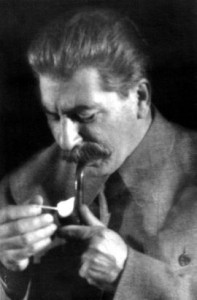Stalin, (Dzhugashvili), Iosif [Josef] Vissarionovich (1878-1953)
Party nickname “Koba.” Soviet Communist Party and government leader, named Marshall of the Soviet Union in 1943 and Generalissimus in 1945. Born into the family of a bootmaker in the Georgian town of Gori, Stalin graduated from the Gori church school and studied at the Tbilisi (then Tiflis) seminary, from which he was expelled in 1899 for revolutionary activity. He joined the Bolshevik party, RCP (b), in 1903, and in 1906-1907 organized the expropriation of bourgeois property (mostly through bank hold-ups) in the Caucasus. By 1917, Stalin had become a member of the Bolshevik Politbureau and the War Revolutionary Center, which organized the 1917 October rebellion that brought the Bolsheviks to power. From 1919 to 1922, Stalin was Narcom for the affairs of nationalities. From 1922 to 1953, he was the General Secretary of the Central Committee of the Communist Party.
While he was a government leader, during many years of struggle between party factions, Stalin used party apparatus to seize absolute power and establish a totalitarian regime. He initiated forced industrialization and the collectivization of agriculture. In the 1930s, to suppress any potential opposition to his absolute power, he organized mass purges and repression, committing acts of mass terror against the population.
From 1941 on, Stalin was also Chairman of the Soviet Government, then called Sovnarcom. From the Nazi invasion of the Soviet Union, on June 22, 1941, until 1945, he was Chairman of the State Committee on Defense (GKO), Narcom of Defense and Commander in Chief. Under pressure from the Nazis, Stalin joined the United States and Great Britain in their anti-Nazi efforts and became part of the “Big Three,” as the Allied leaders Roosevelt, Churchill and Stalin were then called. After the end of World War II, however, Stalin’s relations with the Allies quickly soured, leading to the Cold War. Beginning in 1948, Stalin unleashed a new wave of purges and show trials.
Following Stalin’s death in March 1953, the process of de-Stalinization slowly began, culminating in 1956 with Nikita Kruschev’s anti-Stalin speech at the 20th Party Congress. From 1954 to 1958, most victims of Stalin’s repression were rehabilitated, many of them posthumously? however some would be rehabilitated only in late 1980s.


